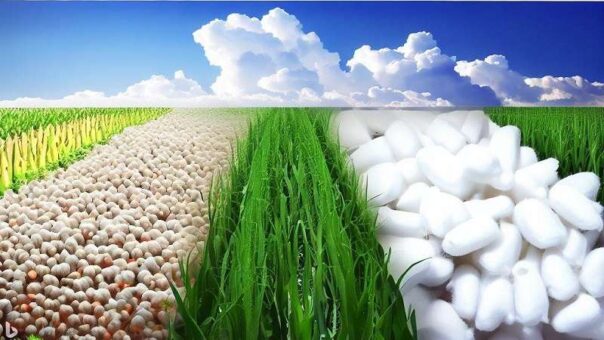Islamabad, June 8, 2023: Despite the devastating impact of flash floods during fiscal year 2022-23, the agriculture sector of Pakistan has recorded a growth of 1.55 percent, according to the Economic Survey of Pakistan released on Thursday.
The survey highlighted that Pakistan experienced heavy monsoon rainfall in July-August 2022, which caused significant damage to two main sub-sectors of agriculture, namely crops and livestock.
The damage in the agriculture sector had a spillover effect on the industry and allied services sectors, resulting in below-par domestic production levels and soaring prices of essential food items. The total damage caused in the agriculture sector amounted to approximately Rs 800 billion (US$3.725 billion). To meet the domestic demand for food items, the government swiftly allowed the import of essential food items on a fast-track basis from neighboring countries.
In an effort to restore the livelihoods of smallholder farmers and livestock keepers and mitigate further losses to livestock assets and production, the government announced the Kissan Package-2022, particularly focusing on the flood-affected areas of Sindh and Balochistan. This was aimed at alleviating the hardships faced by flood affectees and reviving the agriculture sector.
READ MORE: Pakistan Economic Survey 2022-23: Only 0.29% GDP Growth Achieved
Despite the challenges posed by the flash floods, damage to Kharif crops, and the high base effect of last year’s growth of 4.27 percent, the agriculture sector managed to achieve a growth rate of 1.55 percent in FY2023. The important crops experienced a decline of 3.20 percent, with cotton and rice being particularly affected by the floods. Cotton production witnessed a sharp decline of 41.0 percent, resulting in the production of 4.910 million bales compared to 8.329 million bales in the previous year. Similarly, rice production decreased by 21.5 percent, standing at 7.322 million tons compared to 9.323 million tons last year.
However, the decline in important crops was partially compensated by the growth in wheat production (5.4 percent), sugarcane production (2.8 percent), and maize production (6.9 percent). Wheat production reached 27.634 million tons, sugarcane production stood at 91.111 million tons, and maize production amounted to 10.183 million tons, compared to 26.209 million tons, 88.651 million tons, and 9.525 million tons, respectively, in the previous year. Additionally, there was a 0.23 percent increase in other crops, primarily driven by a 53.15 percent growth in oilseed production.
Cotton ginning, with a share of 0.97 percent in agriculture and 0.22 percent in GDP, declined by 23.1 percent due to the decrease in cotton production. Livestock, accounting for 62.68 percent of agriculture and 14.36 percent of GDP, grew at a rate of 3.78 percent compared to 2.25 percent in the previous year. The fishing sector, representing 1.39 percent of agriculture value addition and 0.32 percent of GDP, grew at a rate of 1.44 percent compared to 0.35 percent in the previous year. The forestry sector, with a share of 2.23 percent in agriculture value addition and 0.51 percent in GDP, grew at 3.93 percent, slightly lower than the previous year’s growth of 4.07 percent, mainly due to an increase in timber production.
During the Kharif 2022 season, water availability in Pakistan decreased to 43.3 million-acre feet (MAF) compared to 65.1 MAF in Kharif 2021. However, for the Rabi season 2022-23, water availability increased by 7 percent over Rabi 2021-22, reaching 29.4 MAF.
READ MORE: Pakistan Economic Survey 2022-23: A Challenging Year
In terms of fertilizer production, the overall domestic production during FY2023 (July-March) decreased by 8.3 percent compared to the same period in FY2022. Additionally, fertilizer imports also decreased by 26.2 percent, leading to an overall decrease of 11.2 percent in the availability of fertilizers during FY2023 (July-March). The total offtake of fertilizer nutrients witnessed a decrease of 15 percent. The reduction in fertilizer offtake can be attributed to the high prices of Phosphatic and Potash fertilizers in both the international and domestic markets.
In terms of regional distribution, Punjab accounted for the largest share in urea offtake at 67.7 percent, followed by Sindh (24.4 percent), Khyber Pakhtunkhwa (KP) (4.4 percent), and Balochistan (3.5 percent). To support the agriculture sector, the government provided subsidies in the form of cheap natural gas and budgeted subsidies on Regasified Liquefied Natural Gas (RLNG) for two urea plants and imported urea during FY2023.
During FY2023 (July-March), agricultural lending financial institutions disbursed Rs 1,222 billion, which amounts to 67.2 percent of the overall annual target. This disbursement is 27.5 percent higher than the Rs 958.3 billion disbursed during the same period in the previous year.
The outstanding portfolio of agricultural loans increased by Rs 80.2 billion, reaching Rs 712.9 billion at the end of March 2023, compared to Rs 632.7 billion at the end of March 2022, indicating a growth of 12.7 percent. The number of outstanding borrowers reached 3.04 million in March 2023, indicating the outreach of agricultural loans.
READ MORE: Finance Ministry Launches Pakistan Economic Survey 2022-2023 Today
